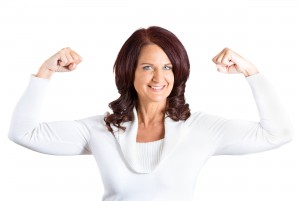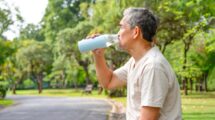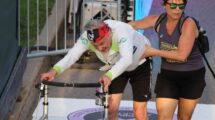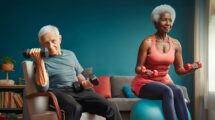
by Peggy Edwards
If you live in Canada, your aging skeleton is likely to be deficient in vitamin D due to a lack of exposure to the sun.
There has been a lot of talk lately about vitamin D—its importance to bone health, and questions about how much we need as we get older and what is the best way to get it? At the same time, debates about calcium go on. The pro- and anti-dairy factions take opposite sides on whether consuming milk and dairy products is the best way to take in calcium and prevent bone fractures. Who is right and what is the best advice for people over age 60?
I decided to look at the current evidence—specifically at some of the best systematic reviews and the most recent recommendations from the Osteoporosis Society. I also talked with my family physician, who actually advised me to start taking a vitamin D supplement.
First, it is important to understand that bone is living tissue. Over the life course, bones are constantly being broken down and built up in a process known as remodeling. We build up our “bone bank” until about age 30; after that, bone loss (destruction) typically exceeds production.
Some people (particularly post-menopausal women) develop osteoporosis—porous weak bones that lead to an increased risk of breaking a bone because of a lack of balance in the destruction versus production process. At least one in three women and one in five men will suffer from an osteoporotic fracture during their lifetime, often with disastrous consequences.
Keeping your bones strong and preventing osteoporosis depends on two things: making the strongest, most dense bones possible during the first 30 years of life, and limiting the amount of bone loss in adulthood.
There are four key things you can do to slow down bone loss in later life.
Stay active. There is no debate in the literature about the importance of regular physical activity to bone health. Physical activity that puts strain or stress on bones causes the bones to retain and possibly gain in density. “Weight- bearing” exercise is best, such as walking, yoga, stair-climb- ing, hiking, tennis, dancing, gardening and lifting weights (not swimming or cycling). Physical activity also builds muscle strength and coordination, which helps you avoid falls and situations that cause fractures.
Get enough vitamin D. Vitamin D is essential for calcium absorption. It is found in dairy products and vitamin supplements, and our skin can make it when it is exposed to sunlight. But not all sunlight is created equal. Above 40 degrees latitude (north of San Francisco and Philadelphia), the winter sunlight isn’t strong enough to promote vitamin D formation. Sunscreens also prevent the formation of vitamin D, although they are still recommended to reduce the risk of sun-induced skin cancer and skin damage.
An examination of clinical trials of vitamin D found that getting 700 to 800 international units (IUs) per day decreases the risk of hip and non-vertebral fractures; and that supplementation with vitamin D reduces the risk of falls among older individuals by more than 20 per cent.
Look for a supplement that provides 800 to 1,000 IUs of vitamin D per day. Older people who are housebound, have darker skin, spend winters in Canada or have osteo- porosis may need more – up to 2,000 IUs per day.As al- ways, it’s a good idea to discuss the use of supplements with your doctor, and whether a vitamin D blood test would be good to do.
Get the right amount of calcium on a daily basis. The body gets calcium, which is essential for bone health, in two ways: by eating foods or taking supplements that contain calcium, and by “borrowing” it from the bones when blood levels of calcium drop too low.This usually happens when it has been a while since ingesting calcium. Ideally, the borrowed calcium is replaced at a later point, but this does not always happen. Hence, the need to get calcium on a daily basis.
Despite the debates surrounding milk and calcium, one thing is clear: adequate calcium is key to reducing the risk for osteoporosis and fractures. However, the healthiest and safest amount of calcium is still unclear. Health Canada recommends that people over age 50 get 1,000 mg (men) to 1,200 mg (women) of calcium each day (established in 2010). However, recent results from long-term studies suggest that consuming these high amounts does not reduce one’s risk for osteoporosis or hip fracture, can cause side effects including constipation and kidney stones, and may be related to other health problems.
It is recommended you get your calcium from food instead of supplements. Dairy products are still the best source of calcium. If you are lactose intolerant/sensitive, or dislike dairy products, you can find calcium in dark green leafy vegetables such as kale and collard greens, in dried beans and legumes, and in fish with soft bones that are eaten, such as canned salmon or sardines. If you cannot get enough calcium from food sources, take a supplement that also includes vitamin D.
Don’t smoke and drink moderately. Older people who smoke are at greater risk for osteoporosis and bone fractures. Drinking alcohol beyond moderation can also impede the absorption of calcium.
The bottom line? We all know someone who has endured the pain associated with bone loss and broken bones. Protect yourself with some simple, informed lifestyle choices.Your skeleton will thank you!
Fun Skeleton Facts
• The femur (that long bone above your knee) is the largest bone in your body and it makes up about 1/4 of your height.
• The smallest bone in your body is in your ear. The stapes (commonly called the stirrup) is smaller than a grain of rice.
• When you were born, you had about 300 bones in your body. Adults only have about 206 bones. As you grow, some of your bones join together to make your skeleton stronger.
I’m looking forward to hearing your ideas on topics for this column and comments about what you read here. Are you concerned about your bone health? What do you plan to do about it? Write to me at epeggy1948@gmail.com. It’s going to be a good conversation!






